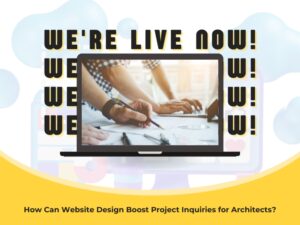How Can Website Design Boost Project Inquiries for Architects?

A well-designed website can be the difference between a flood of project inquiries and a quiet inbox. For Australian businesses, especially those in competitive industries like architecture, electricians, and videography, a professional, user-friendly site builds trust and encourages visitors to take action. But how exactly does website design influence project inquiries? This article explores how website design influences project inquiries and what elements can help increase engagement.
How does website design impact client trust?
First impressions matter. When potential clients land on a website, they quickly decide whether they trust the business. A cluttered or outdated site can push them away, while a clean, professional design keeps them engaged. Trust is essential for inquiries, and website design plays a crucial role in building that trust.
Why trust matters:
- Credibility: A polished, functional website shows that a business takes its online presence seriously.
- Security indicators: HTTPS encryption and secure payment gateways put visitors at ease.
- Contact information: Easy-to-find phone numbers, emails, and contact forms encourage users to reach out.
- Accessibility compliance: Understanding the importance of website accessibility guidelines ensures inclusivity and demonstrates a commitment to serving all users, further enhancing trust.
Key trust-building elements:
- Professional design that reflects industry standards
- Clear, concise content that answers visitor questions
- Testimonials and case studies showcasing past success
Stat to consider:
A study found that 75% of users judge a company’s credibility based on its website design.
What website design elements increase project inquiries?
Not all websites are created equal. To maximise project inquiries, certain design elements must be optimised to encourage visitor engagement and action. Here are key design elements to focus on:
Element | Impact on Inquiries |
Clear Call-to-Actions (CTAs) | Directs visitors towards inquiry forms. |
Mobile Responsiveness | Ensures seamless experience on all devices. |
Fast Loading Times | Reduces bounce rates and improves engagement. |
User-Friendly Navigation | Helps visitors find information quickly. |
Contact Forms | Simplifies the inquiry process. |
Why do visual elements matter when generating project inquiries on architectural websites?
For architects and designers, visual impact is everything. A well-crafted website isn’t just a digital portfolio—it’s a powerful tool for attracting and converting potential clients. High-quality visuals not only showcase expertise but also build trust by giving visitors a clear sense of an architect’s style and capabilities. To maximise engagement, specialised website design services for architectural firms ensure that these visual elements are strategically presented, making it easier for potential clients to explore past projects and take the next step toward an inquiry.
Key visual elements:
- Portfolio galleries:
- Use high-resolution images to showcase completed projects.
- Include before-and-after shots to highlight transformations.
- Video walkthroughs:
- Give clients a virtual tour of past projects.
- Engages visitors and keeps them on the site longer.
- Consistent branding:
- Use a colour scheme and typography that reflect the business identity.
- Reinforce brand recognition and professionalism.

Did you know?
Websites with compelling visuals can increase conversion rates by 37%.
Why is showcasing a portfolio essential for engagement?
A portfolio acts as proof of your expertise. Clients want to see examples of past work before making an inquiry. Here’s what makes an effective portfolio:
- Organised categories – Group projects by industry, style, or service.
- Client testimonials – Reinforce credibility and customer satisfaction.
- Project descriptions – Explain challenges, solutions, and results.
- High-resolution images – Professional, high-quality visuals showcase expertise.
Example of an effective project showcase structure:
Project Name | Industry | Challenge | Solution | Outcome |
Smith Residence | Residential Architecture | Limited natural light | Open-plan design with skylights | Increased natural lighting by 60% |
Urban Office Redesign | Commercial | Lack of collaboration spaces | Created modern, open workspaces | Boosted productivity by 35% |
How does website design influence SEO for increasing project inquiries?
Search engine optimisation (SEO) and website design go hand in hand. A beautifully designed website is useless if potential clients can’t find it. By optimising design elements, Australian businesses can increase their visibility and drive more project inquiries.
SEO factors influenced by design:
- Mobile-friendliness: Google prioritises mobile-first websites, which means sites that work seamlessly on smartphones and tablets rank higher. Responsive design is crucial since over 60% of searches come from mobile devices.
- Page speed: Fast-loading pages improve user satisfaction and reduce bounce rates. Slow websites frustrate users and signal search engines that the site may not offer a positive experience, lowering rankings. Compressing images, enabling browser caching, and minimising code can improve page speed.
- User experience (UX): Intuitive navigation, clear CTAs, and engaging content keep visitors on the site longer. When users stay engaged, search engines see this as a positive signal, improving the website’s ranking and increasing the likelihood of project inquiries.
- Structured data: Structured data, or schema markup, helps search engines understand website content better. This enhances rich snippets, making your site stand out in search results and encouraging more clicks.
What are the common website mistakes that deter inquiries?
Even the best businesses can lose potential clients if their websites have critical design flaws. Identifying and addressing these issues can significantly increase project inquiries.
Common website mistakes:
- Slow loading speed: Visitors expect a website to load within 3 seconds. A slow site frustrates users and increases bounce rates, signalling search engines that the site provides a poor experience.
- Confusing navigation: When users struggle to find essential information, they’re likely to leave. Complicated menu structures and unclear pathways deter inquiries by making it difficult for visitors to take action. This highlights the importance of simplicity in website design for visitor conversions, as streamlined layouts and intuitive navigation guide users toward inquiries.
- Poor mobile optimisation: With over 60% of web traffic coming from mobile devices, websites that aren’t optimised for smartphones and tablets risk alienating potential clients. A non-responsive site can make navigation difficult and reduce inquiries.
- Lack of clear CTAs: Without visible and action-oriented calls to action (CTAs), visitors won’t know what steps to take next. This reduces engagement and lowers inquiry rates.

How to fix these mistakes:
- Compress images and use caching for faster load times.
- Implement responsive design for mobile devices.
- Simplify menu structures and ensure intuitive navigation.
- Add clear, action-oriented CTAs on key pages.
Identifying and addressing design flaws can significantly boost project inquiries. However, before making improvements, it’s essential to follow steps to assess a website’s design and layout effectively. This approach helps pinpoint areas that may deter potential clients and ensures that the website aligns with user expectations.
Polished websites bring more inquiries
Website design isn’t just about aesthetics—it directly impacts project inquiries by building trust, enhancing user experience, and supporting SEO efforts. For Australian businesses, a well-designed website can mean the difference between capturing leads and losing them to competitors. Whether you’re an architect, mechanic, or restaurateur, investing in a professional, user-friendly website is a smart move. If you’re considering upgrading your website, learn what Nifty Websites Australia can offer your business.
